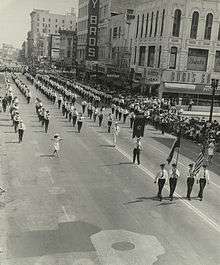Synchronization

Synchronization is the coordination of events to operate a system in unison. The familiar conductor of an orchestra serves to keep the orchestra in time. Systems operating with all their parts in synchrony are said to be synchronous or in sync; those which are not are asynchronous.
Today, synchronization can occur on a global basis through the GPS-enabled timekeeping systems (and similar independent systems operated by the EU and Russia).
Transport
Time-keeping and synchronization of clocks was a critical problem in long-distance ocean navigation; accurate time is required in conjunction with astronomical observations to determine how far East or West a vessel has traveled. The invention of an accurate marine chronometer revolutionized marine navigation. By the end of the 19th century, time signals in the form of a signal gun, flag, or dropping time ball, were provided at important ports so that mariners could check their chronometers for error.
Synchronization was important in the operation of 19th century railways, these being the first major means of transport fast enough for the differences in local time between adjacent towns to be noticeable. Each line handled the problem by synchronizing all its stations to headquarters as a standard railroad time. In some territories, sharing of single railroad tracks was controlled by the timetable. The need for strict timekeeping led the companies to settle on one standard, and civil authorities eventually abandoned local mean solar time in favor of that standard.
Communication
In electrical engineering terms, for digital logic and data transfer, a synchronous circuit requires a clock signal. However, the use of the word "clock" in this sense is different from the typical sense of a clock as a device that keeps track of time-of-day; the clock signal simply signals the start and/or end of some time period, often very minute (measured in microseconds or nanoseconds), that has an arbitrary relationship to sidereal, solar, or lunar time, or to any other system of measurement of the passage of minutes, hours, and days.
In a different sense, electronic systems are sometimes synchronized to make events at points far apart appear simultaneous or near-simultaneous from a certain perspective. (Albert Einstein proved in 1905 in his first relativity paper that there actually are no such things as absolutely simultaneous events.) Timekeeping technologies such as the GPS satellites and Network Time Protocol (NTP) provide real-time access to a close approximation to the UTC timescale and are used for many terrestrial synchronization applications of this kind.
Synchronization is an important concept in the following fields:
- Computer science (In computer science, especially parallel computing, synchronization refers to the coordination of simultaneous threads or processes to complete a task with correct runtime order and no unexpected race conditions.)
- Cryptography
- Multimedia
- Music (Rhythm)
- Neuroscience
- Photography
- Physics (The idea of simultaneity has many difficulties, both in practice and theory.)
- Synthesizers
- Telecommunication
Synchronization (Dynamical Systems)
Synchronization of multiple interacting dynamical systems can occur when the systems are autonomous oscillators. For instance, integrate-and-fire oscillators with either two-way (symmetric) or one-way coupling can synchronize when the strength of the coupling (in frequency units) is greater than the differences among the free-running natural oscillator frequencies. Poincare phase oscillators are model systems that can interact and partially synchronize within random or regular networks.[1] In the case of global synchronization of phase oscillators, an abrupt transition from unsynchronized to full synchronization takes place when the coupling strength exceeds a critical threshold. This is known as the Kuramoto model phase transition. Synchronization is an emergent property that occurs in a broad range of dynamical systems, including neural signaling, the beating of the heart and the synchronization of fire-fly light waves.
Uses
- Film synchronization of image and sound in sound film.
- Synchronization is important in fields such as digital telephony, video and digital audio where streams of sampled data are manipulated.
- In electric power systems, alternator synchronization is required when multiple generators are connected to an electrical grid.
- Arbiters are needed in digital electronic systems such as microprocessors to deal with asynchronous inputs. There are also electronic digital circuits called synchronizers that attempt to perform arbitration in one clock cycle. Synchronizers, unlike arbiters, are prone to failure. (See metastability in electronics).
- Encryption systems usually require some synchronization mechanism to ensure that the receiving cipher is decoding the right bits at the right time.
- Automotive transmissions contain synchronizers that bring the toothed rotating parts (gears and splined shaft) to the same rotational velocity before engaging the teeth.
- Film, video, and audio applications use time code to synchronize audio and video.
- Flash photography, see Flash synchronization
Some systems may be only approximately synchronized, or plesiochronous. Some applications require that relative offsets between events be determined. For others, only the order of the event is important.
See also
- Asynchrony
- Atomic clock
- Clock synchronization
- Data synchronization
- Double-ended synchronization
- Einstein synchronization
- Entrainment
- File synchronization
- Flywheel
- Homochronous
- Kuramoto model
- Mutual exclusion
- Neural synchronization
- Phase-locked loops
- Phase synchronization
- Reciprocal socialization
- Synchronism
- Synchronization (alternating current)
- Synchronization in telecommunications
- Synchronization of chaos
- Synchronization rights
- Synchronizer
- Synchronous conferencing
- Time
- Timing Synchronization Function (TSF)
- Time transfer
- Timecode
- Tuning fork
- Order synchronization and related topics
- Rendezvous problem
- Interlocking
- Race condition
- Concurrency control
- Room synchronization
- Comparison of synchronous and asynchronous signalling
- Video and audio engineering
- Aircraft gun engineering
- Compare with
- Synchronicity, an alternative organizing principle to causality conceived by Carl Jung.
References
- ↑ Nolte, David (2015). Introduction to Modern Dynamics: Chaos, Networks, Space and Time. Oxford University Press.
External links
| Look up synchronization in Wiktionary, the free dictionary. |